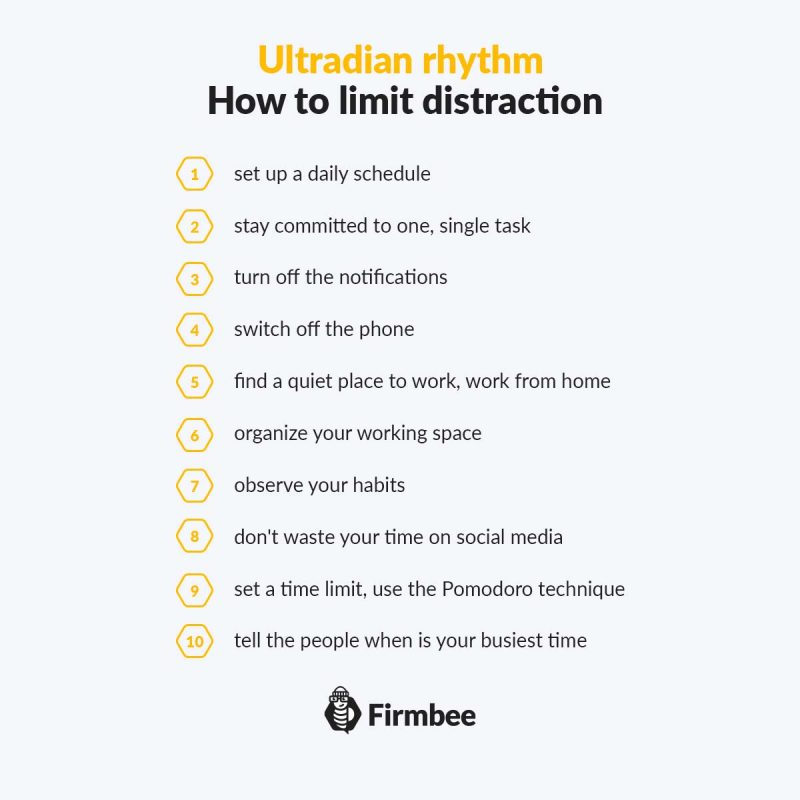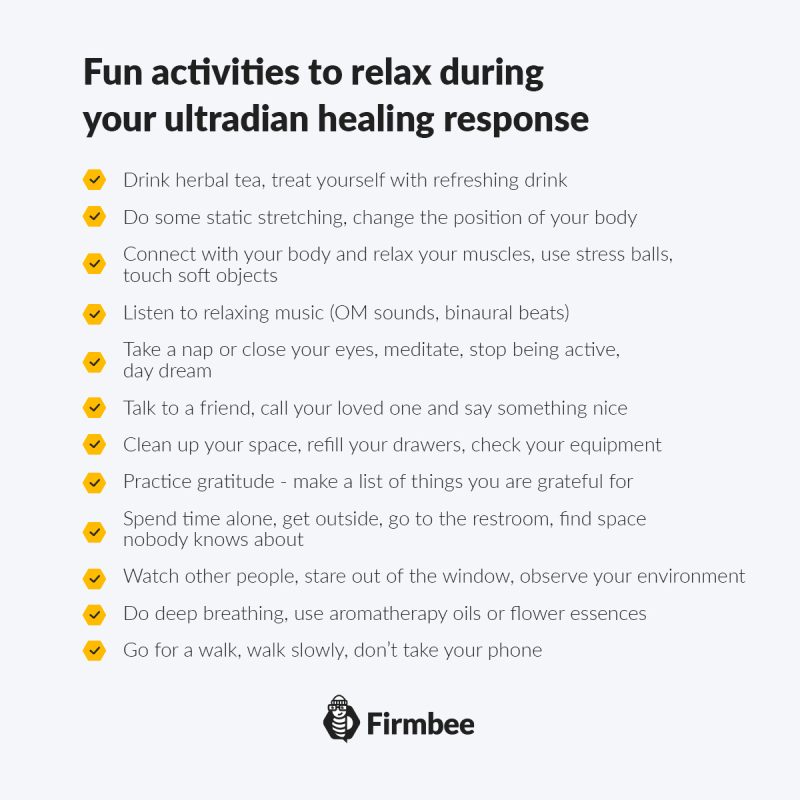What is ultradian rhythm? How rhythms of nature can influence our productivity? Are there any ways to harness the forces of nature to get more energy and increase our mental and physical capacities? How following natural flows of energy can help us to live in harmony with our bodies and avoid exhaustion? How to avoid burnout and boost your performance using the natural rhythms of your body?
What is ultradian rhythm? – table of contents:
What is ultradian rhythm?
Nature, this huge, wild, and unpredictable entity was never easy to harness. Humans used science, technology, and all possible means to divide themselves from the danger that is associated with the natural environment. Our cities protect us from wind, water, and fire, our civilization gives us the illusion of control. We have tried to forget that nature is a part of us and we cannot fight what is bigger than ourselves.
In our approach to productivity, we seem to be as naive as in many other situations, we wish to work all day long, pretending we are as efficient as soulless machines, and we get frustrated and disappointed that it doesn’t work – we cannot be productive the whole time, we get fatigued, our brain loses clarity, our memory fails us, good mood disappears for no reason. We eat healthy food, we exercise frequently and we have ample sleep and still, we experience those weaker moments, when we cannot show how good we are and how seriously we treat our everyday duties. What can be wrong?
Most people are unaware of cyclical changes that occur in nature. Obviously, we know about the seasons, we observe day and night, and we are fully aware of the fact that animals have their migration, breeding, or hibernation times, but not all of us know about less visible, less notoriously advertised cycles that are a part of our everyday experience.
All the above phenomena belong to the different types of natural rhythms.
In chronobiology, there are three types of rhythms:
- Circadian rhythm, or circadian cycle, is a natural cycle of the body that regulates internal bodily processes at 24-hour intervals. It is regulated by the internal circadian clock that is located in the brain and regulates the sleep-wake cycle and other essential bodily functions. Circadian rhythm is crucial for the good functioning of the human and affects virtually all the important systems of the body. The very first symptom of disturbed circadian rhythm is insomnia and other sleep problems. But there is more to worry about – circadian rhythm influences: metabolism, mental health, and immune system.
- Infradian rhythm – is a rhythm that is longer than a circadian rhythm (longer than 24 hours), but its length may vary. The infradian rhythm is sometimes referred to as the body’s second clock, while the circadian rhythm is the first. Among infradian rhythms found in mammals are menstruation, breeding, migration, hibernation, hair growth, tidal, seasonal, and tidal rhythms. Infradian rhythm is important for human health and wellbeing. It plays a major role in regulating: the brain, metabolisms, immune system, microbiome, stress response system, and reproductive system. The most known infradian rhythm are menstrual cycle, but other seasonal disorders, known to all people (change of mood during seasons) may be seen as types of infradian cycles as well.
- Ultradian rhythms – are the shortest biological rhythms experienced by human beings. Ultradian rhythms are shorter than a 24-hour cycle and can be as short as several minutes and take up to 10 hours.
Ultradian rhythm was discovered by Nathaniel Kleitman during his research on sleep in the 1950s. Kleitman has established that the human body experiences different stages of sleep such as alertness, REM phase, and deep sleep.
Those cycles correspond to similar cycles during the day when humans go through different phases of alertness. Ultradian rhythm is known as Basic Rest Activity Cycle and its basic structure predicts that the brain enters the high-frequency alertness phase for 90 minutes and then it moves into a period of 20-minute rest phase.

What does it mean for our work schedule? Since were are designed to work efficiently for a limited time, we have to use those moments of alertness to the full. After the 90-minutes of activity, we have to rest otherwise we push our system to its limits.
Traditionally, in our workplaces, we were expected to work for a certain time of the day without longer breaks and with the same, steady capacity. No matter the mood or the needs of the brain, a good employee should always stay occupied. When fatigue comes we feel that we are losing a battle and since we cannot just give up, we drink coffee or eat something sweet to bring the alertness back. Eventually, we are destined to fail. The more we fight nature the less productive, more stressed, and more fatigued we become.
How to align your day to the ultradian rhythm?
The implications of the scientific finding of Nathaniel Kleitman are clear. For effective work short periods of rest are necessary.
It is important to remember that the classical 8 hours work schedule was never designed for health or optimum productivity. This model is still prevalent all over the world, probably because of a lack of better, more aligned scientific knowledge, and standards, and we know it is disadvantageous from the perspective of productivity, but still, it is much better than anything before.
The 8-hour model was devised as a reaction to XIX century poor work standards when workers were expected to work even 16 hours per day. At that time occurrences of death due to exhaustion was the order of the day. In the late 19th century the new concept, the 8-hour working day model was discussed in both British and American parliaments (and had many opponents). The very first to introduce it in his factories was Henry Ford in 1905.
From this moment employees were expected to be focused and productive for the entire 8 hours of their working time. Today we know that even this human approach cannot provide maximum productivity and will have to be adjusted in the future.
Working schedules based on ultradian rhythms are the future of the business organization.
The secret of success is not great time management but great energy management. So how can you build your day around your ultradian rhythm? First of all, you don’t have to stick to the 8-hour working practice, which forces you to work constantly. Instead of this, try to be more attuned with your own body and observe your peak and weak moments. Take breaks, whenever you feel the need, and try to be fully focused at your moments of high concentration.

A typical routine based on the ultradian rhythms principle is extremely easy to follow.
- Spend between 60 to 90 minutes on your important task, work fast, be focused, and limit distraction to a minimum
- Take a 20-minute break after 60-90 minutes, don’t work during your break, leave your desk, relax, and allow your brain to rejuvenate
While designing your new work schedule you have to remember about limiting the distractions. You need to be fully focused to use your brain powers during the 90-minute stage otherwise you risk that your day will be as unproductive as it can be. When you start feeling tired, groggy, irritable, hungry, or fidgety don’t fight the urge to move and rest. Take a few deep breaths, take a walk, and don’t try to work despite the feeling of fatigue.
Skipping rest for several months will result in many health issues. What kind of symptoms are associated with bad energy organization? On the physical spectrum you may observe: an increase in blood pressure, low immunity, higher cholesterol, slowed metabolism, and digestive problems. Psychologically stress related to lack of balance results in memory problems, depression, and declining mental capability. The ultradian rhythm is a part of our structure and cannot be ignored. You have to rest properly after each 90-minute blitz to stay not only productive but healthy.

Following ultradian rhythms can be applied to every aspect of our life not only to productivity. All tasks can be done effectively, quickly and without effort, if only performed at the right time of the day. Following rhythms of nature seems to be one of many ways that allow for lowering fatigue and increasing productiveness.
Conscientious individuals seek to advance in every aspect of their life – they wish to be healthy, efficient, fast, and successful, therefore they search for the information that helps better their performance. Great nutrition, ample exercise, time for meditation, focus, and mindfulness plus the huge body of scientific evidence may not be enough when there is no basic knowledge about the ultradian rhythm of the body because it directly regulates our ability to be productive and cannot be ignored if we wish to operate at a higher level.
If you like our content, join our busy bees community on Facebook, Twitter, LinkedIn, Instagram, YouTube, Pinterest.
Author: Caroline Becker
As a Project Manager, Caroline is an expert in finding new methods to design the best workflows and optimize processes. Her organizational skills and ability to work under time pressure make her the best person to turn complicated projects into reality.


















